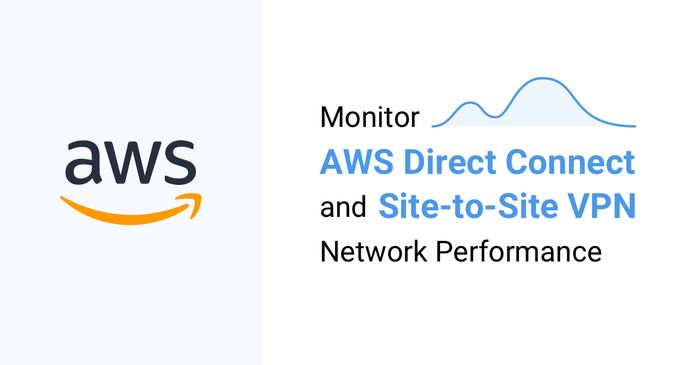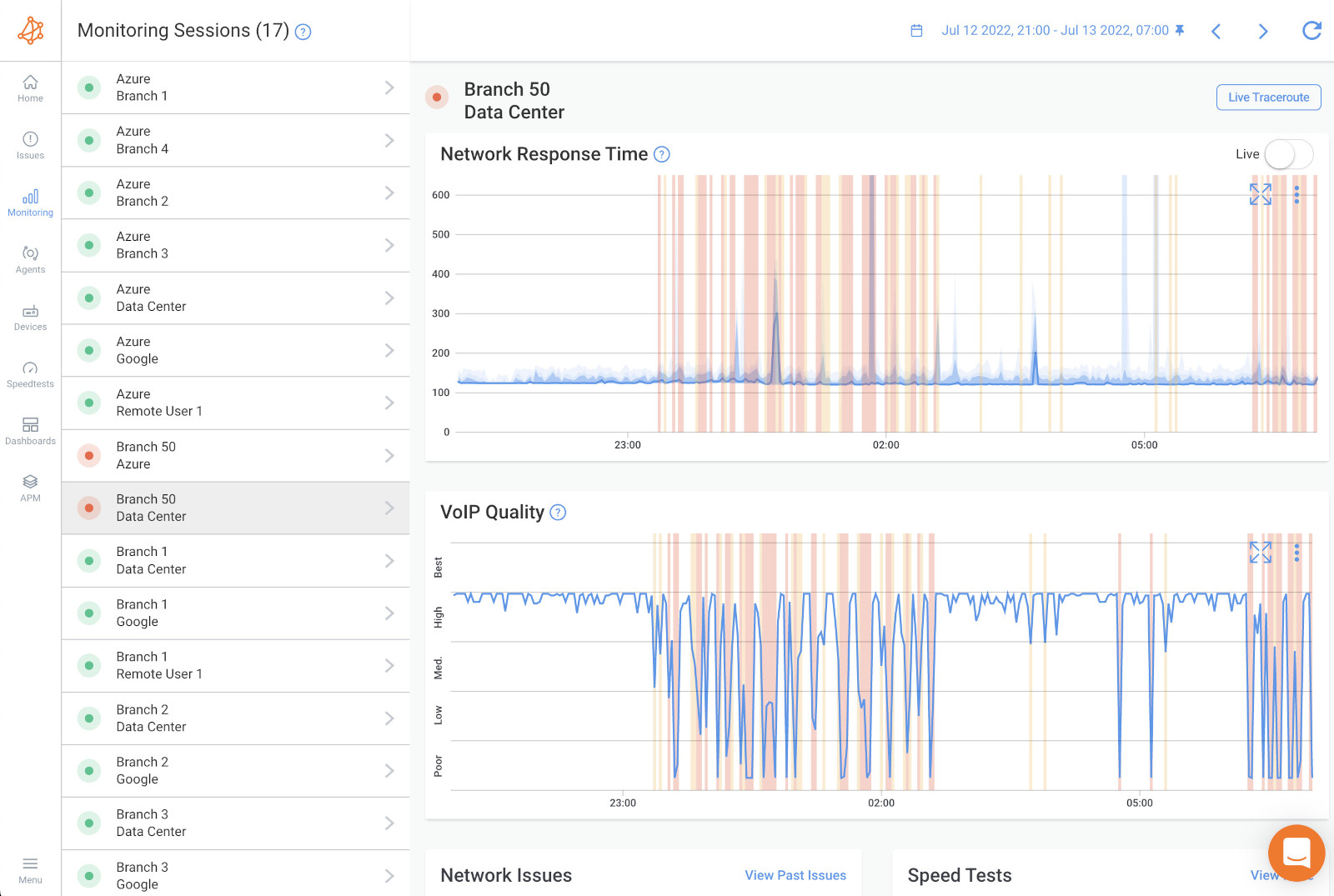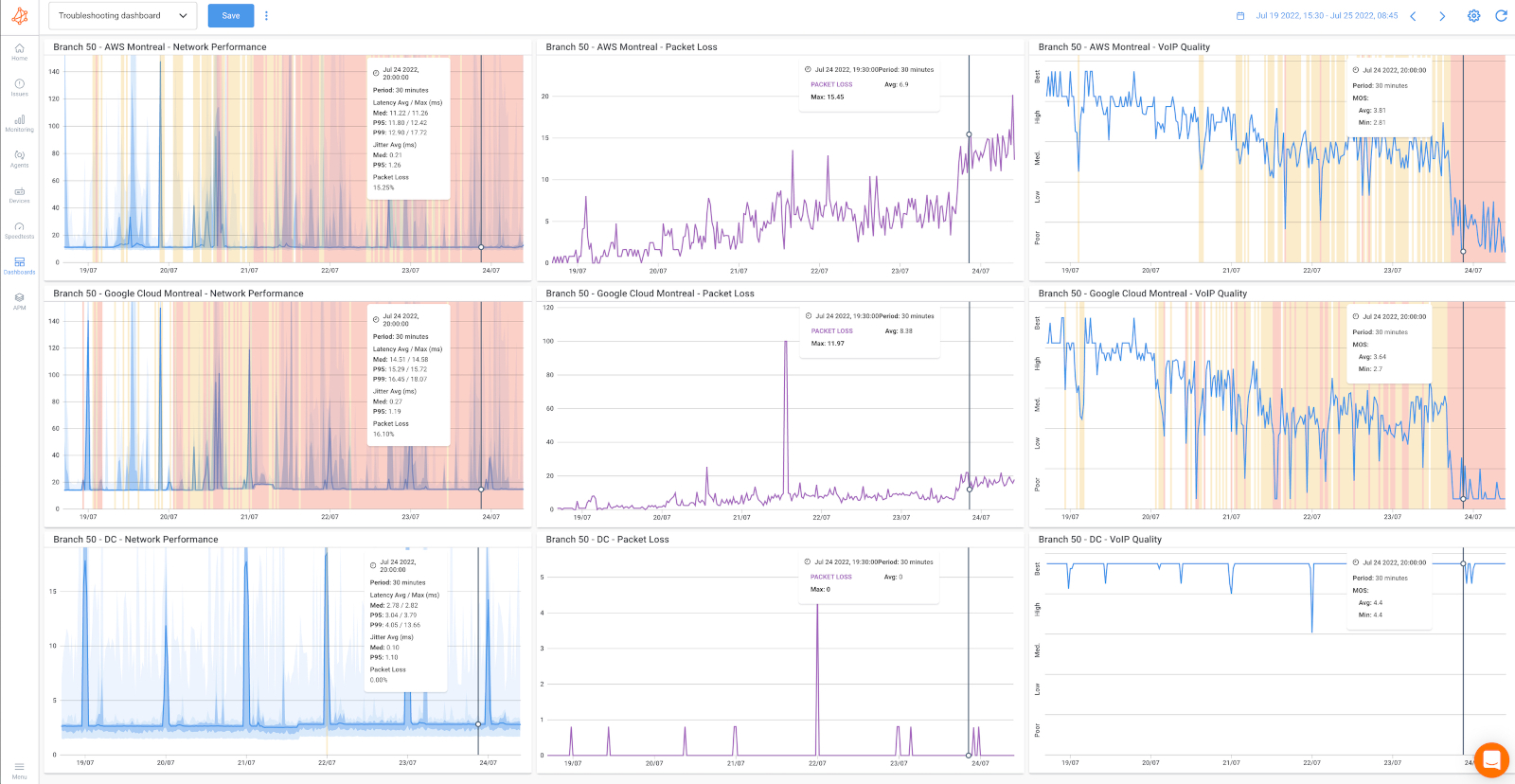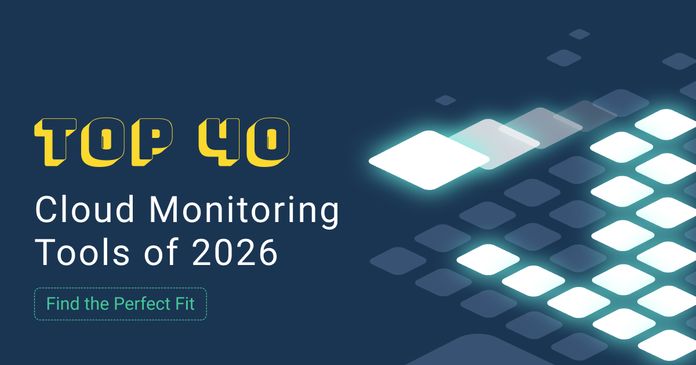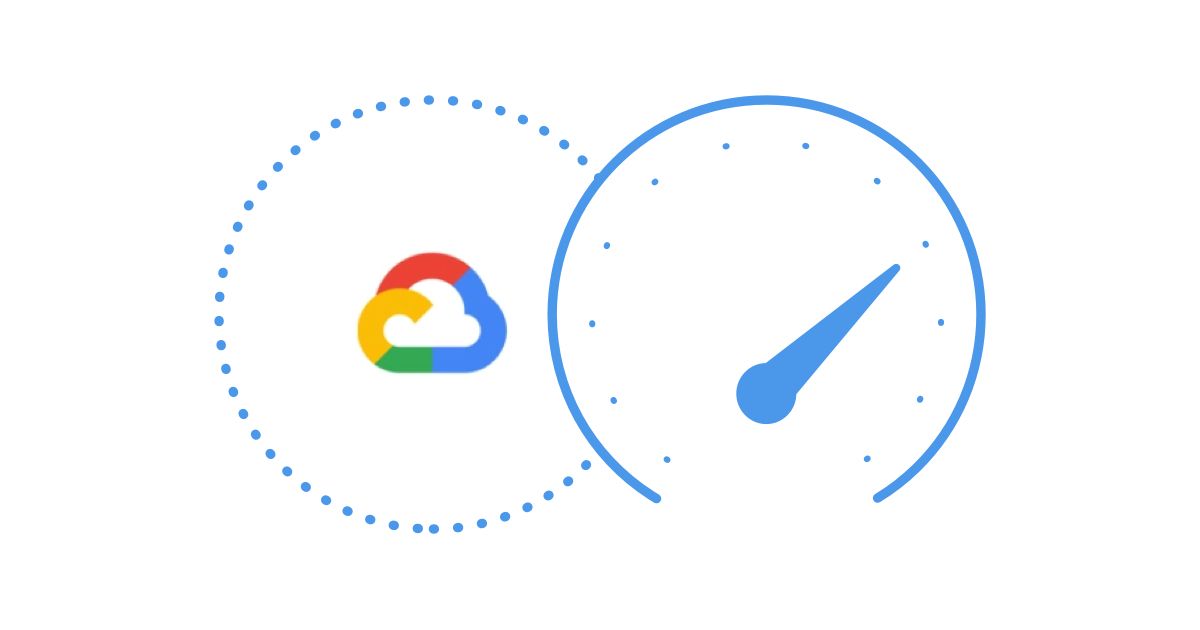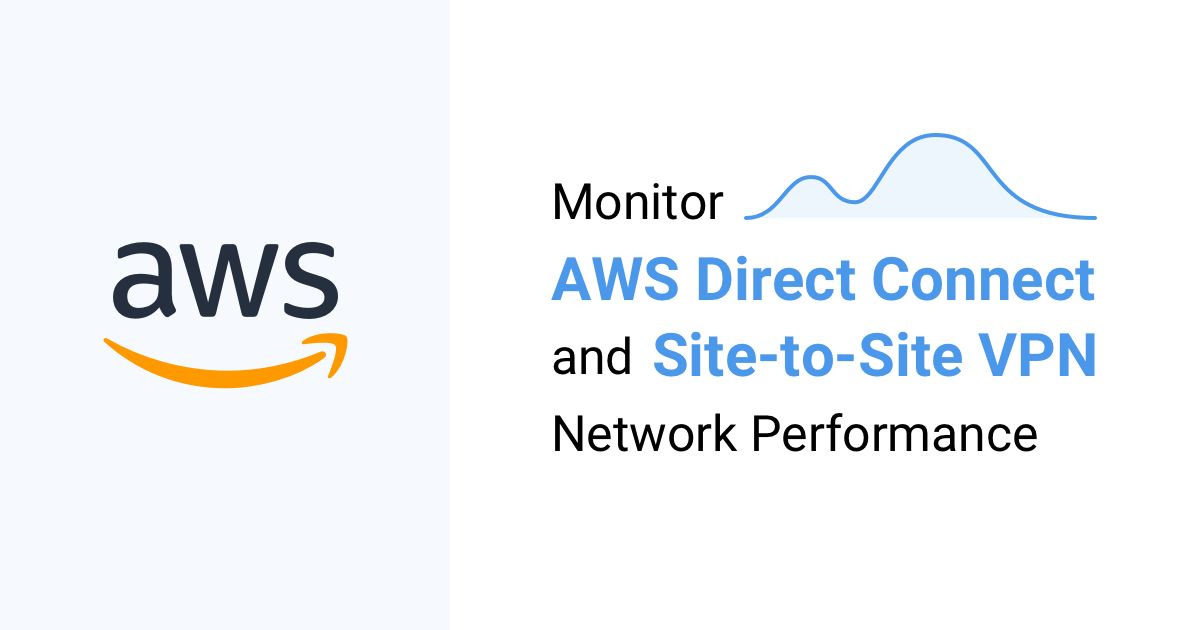Table of Contents
Table of Contents
In today's interconnected world, where information travels at the speed of thought, reliable network performance is the key to success. And when it comes to cloud computing, Google Cloud Interconnect takes center stage. This robust infrastructure allows businesses to establish dedicated connections between their on-premises networks and Google Cloud Platform (GCP), ensuring seamless data transfer and high-performance computing.
But here's the catch: without proper monitoring, even the most sophisticated network can hit a snag. Continuously monitoring Google Cloud Interconnect performance is the key to identifying slowdowns, high levels of packet loss, and other problems affecting Google Cloud.
So, if you're eager to unlock the secrets of monitoring Google Cloud Interconnect and network performance, you've come to the right place. In this blog post, we'll equip you with the knowledge and tools you need to navigate the digital skies with confidence. Keep reading to learn how to do it all in minutes using Obkio Network Monitoring!
Google Cloud Interconnect is a service provided by Google Cloud Platform (GCP) that enables businesses to establish high-bandwidth, private network connections between their on-premises data centers or networks and Google Cloud. It offers a secure and reliable method to connect your organization's infrastructure directly to Google's network, bypassing the public internet.
With Google Cloud Interconnect, you can establish dedicated connections that provide higher throughput, lower latency, and more consistent network performance compared to typical internet connections. This makes it ideal for applications that require low-latency access to cloud resources or need to transfer large amounts of data.
Google Cloud Interconnect supports two main types of connections: Dedicated Interconnect and Partner Interconnect.
- Dedicated Interconnect: This option allows you to establish a direct physical connection between your on-premises network and Google's network at one of Google's dedicated interconnect locations. This provides a private and secure connection with high capacity, ranging from 10 Gbps to 100 Gbps. Dedicated Interconnect offers a fixed, predictable cost and can be a cost-effective choice for organizations with significant data transfer needs or stringent network requirements.
- Partner Interconnect: Partner Interconnect enables you to connect to Google Cloud using a partner's network service provider. Instead of connecting directly to Google's network, you establish a connection with a partner's network, and the partner then connects to Google's network on your behalf. This option provides more flexibility in terms of geographic coverage and can be suitable for organizations with lower bandwidth requirements.
By leveraging Google Cloud Interconnect, businesses can enjoy enhanced network performance, improved security, and increased reliability for their data transfers between on-premises infrastructure and Google Cloud.

In this article, we’ll be explaining why and how to monitor the network performance of Google Cloud Interconnect between your on-premise infrastructure up to the Google Cloud.
You can follow the exact same steps to do the same with:
Discover end-to-end Direct Connect Monitoring with Obkio! Identifying AWS network issues for seamless premise-to-cloud connectivity. Learn more!
Learn more

How Does Network Performance Affect Google Cloud Interconnect: The Need for Google Cloud Interconnect Monitoring
Network performance plays a crucial role in the effectiveness and efficiency of Google Cloud Interconnect. The performance of the network connection between your on-premises infrastructure and Google Cloud can directly impact the overall user experience, data transfer speeds, and application performance.
Here are a few key aspects where network performance can influence Google Cloud Interconnect:
- Latency: Latency refers to the time delay between sending a request from your on-premises network to Google Cloud and receiving a response. Lower latency is desirable for real-time applications, such as video conferencing, online gaming, or financial transactions. Network performance issues, such as high latency, can lead to noticeable delays, affecting the responsiveness of applications and user experience.
- Bandwidth Utilization: Bandwidth utilization refers to the amount of network capacity utilized by your data transfers between your on-premises network and Google Cloud. If your network connection doesn't provide sufficient bandwidth, it can result in bottlenecks and slow data transfer speeds. Adequate network performance with high bandwidth availability ensures smooth and efficient data transfers, especially for large-scale data migration or accessing bandwidth-intensive services in the cloud.
- Packet Loss: Packet loss occurs when data packets are dropped or lost during transmission. Even minor packet loss can impact the integrity and reliability of your data transfers. It can lead to retransmissions, delays, and reduced throughput. Network performance issues, such as congestion, faulty network equipment, or inadequate buffering, can contribute to packet loss. Monitoring packet loss and taking corrective measures is essential to maintain the quality and reliability of your Google Cloud Interconnect.
- Network Reliability: A reliable network connection is crucial to ensure uninterrupted access to Google Cloud resources and services. Network performance issues like frequent outages, high jitter (variance in packet arrival times), or unstable connections can disrupt your operations and cause service interruptions. Proactive network monitoring and network connection monitoring and timely troubleshooting of network performance problems are essential to maintain a stable and dependable Google Cloud Interconnect.
Monitor Google Cloud Interconnect plays a huge role in optimizing network performance for Google Cloud Interconnect by identifying network issues, and finding areas for improvement. Let's get into it!
Are you prepared to optimize your network and Cloud performance to new heights? Don't let anything hold you back from reaching the networks clouds - sign up for Obkio's network performance monitoring tool now and let Obkio guide you towards optimized Microsoft Azure ExpressRoute performance.

- 14-day free trial of all premium features
- Deploy in just 10 minutes
- Monitor performance in all key network locations
- Measure real-time network metrics
- Identify and troubleshoot live network problems

Some people may already have a monitoring system that analyzes devices and alerts you if the device is down or if the CPU usage is too high. That's a good thing and you should keep that - but it’s not enough.
What happens if your service provider or cloud provider encounters issues such as a high network congestion that causes severe levels of packet loss loss?
The faster you identify those network problems, the faster you can troubleshoot, and reduce the time it affects your customers or end-users.
A good performance monitoring solution allows you to easily identify, measure, and understand problems affecting your network and cloud infrastructure. Measuring and monitoring is the first step to troubleshooting network issues.
Monitoring Google Cloud Interconnect is crucial for several reasons:
- Performance Optimization: Monitoring allows you to track key performance metrics such as latency, bandwidth utilization, packet loss, and throughput. By continuously monitoring these metrics, you can identify bottlenecks, detect anomalies, and optimize your network configuration for improved performance. Monitoring helps you ensure that your Google Cloud Interconnect is operating at its best, delivering optimal network performance and user experience.
- Troubleshooting and Issue Resolution: Network issues can arise at any time, impacting the performance and availability of your Google Cloud Interconnect. By monitoring your network, you can quickly identify and diagnose problems, enabling timely troubleshooting and resolution. Whether it's a connectivity issue, excessive latency, or abnormal packet loss, monitoring helps you pinpoint the root cause and take corrective actions to minimize downtime and maintain a reliable network connection.
- Capacity Planning: Monitoring provides insights into your network utilization patterns, helping you understand how your Google Cloud Interconnect handles traffic during peak usage periods. By analyzing historical data and trends, you can anticipate capacity requirements and plan for scaling your network infrastructure accordingly. This proactive approach ensures that your network can handle increasing demands, preventing performance degradation or bottlenecks due to inadequate capacity.
- Cost Optimization: Monitoring helps you gain visibility into your network utilization and bandwidth requirements. By tracking bandwidth usage, you can identify underutilized or overutilized resources and make informed decisions about resource allocation. This allows you to optimize your network capacity, potentially reducing costs by eliminating unnecessary resources or adjusting capacity to match your actual needs.
- Security and Compliance: Monitoring your Google Cloud Interconnect allows you to detect any suspicious activities or security breaches promptly. By monitoring network traffic, you can identify anomalies, unusual data transfers, or unauthorized access attempts, enabling you to take immediate action to mitigate potential security risks. Monitoring also helps you meet compliance requirements by providing audit trails and evidence of network activity.
- Service Level Agreement (SLA) Compliance: If you have a Service Level Agreement with Google Cloud or any third-party network service providers, monitoring becomes crucial for ensuring compliance. By monitoring performance metrics and comparing them against SLA commitments, you can verify if the agreed-upon service levels are being met. In case of any deviations, monitoring helps you initiate discussions with the relevant parties and take appropriate actions to address the situation.
In summary, monitoring Google Cloud Interconnect is essential for optimizing performance, resolving issues promptly, planning for scalability, optimizing costs, ensuring security and compliance, and validating SLA compliance. By keeping a close eye on your network performance, you can maintain a robust and reliable connection to Google Cloud, enabling smooth operations and maximizing the benefits of cloud computing.
Now we're going to teach you how to set up Google Cloud Interconnect monitoring using Obkio.
This setup only takes a few minutes and allows you to continuously monitor Google Cloud Interconnect performance to ensure you’re getting the performance you need.
To continuously monitor AWS Direct Connect performance, we recommend using a tool like Obkio Network Performance Monitoring software, to do the work for you.
A network monitoring software can continuously monitor end-to-end network performance and identify network issues for you - and with Obkio, you can be sure it’ll be quick and easy to use.
To get your very own Google Cloud Interconnect monitoring tool:

As with every Obkio network monitoring setup, you need to deploy Network Monitoring Agents.
The Monitoring Agent is unique software that we have developed to measure network and application performance and availability.
For this setup, we need to monitor the network performance between Google Cloud and your on-premise infrastructure. So we need to deploy two Agents:
The Google Cloud Monitoring Agent is hosted and maintained by Obkio in the Google Cloud infrastructure, which means that they can be deployed within seconds.
They allow you to proactively monitor network performance between your standard on-premise Agents and the Google Cloud Platform. With 360-degree visibility, you can easily identify the source and cause of network issues affecting Google Cloud Interconnect based on the monitoring data from these Monitoring Agents.
For more information about deploying this Monitoring Agent type, refer to our Documentation
You need to deploy a minimum of more than two Agents to more accurately compare data between two points.
For example: If you’re monitoring Google network performance between your Head Office and your Internet, deploy:
- One Agent in our Head Office
- And 2 Agents to monitor Internet performance and Internet problems (example, a Google Cloud Agent and an AWS Agent).
With multiple Agents deployed, if you have a network problem, you can easily see if that same problem is affecting all your sites or just one.
If the problem is affecting all your sites, having Agents allows you to collect the most accurate data to troubleshoot and create a comparison point.
- If you have Linux servers, the Software version is perfect.
- If you have a Hyper-V or VMware environment, the Virtual Appliance is ideal.
- Otherwise, there are also Hardware agents, which are very easy to deploy.
Once you’ve installed all your Agents, you’ll need to setup two configurations in the App:
You need to install all Agents in the same Network. When two agents are in the same Network, they will communicate using private IPs instead of Public IPs.
You’ll also need to configure a Network Monitoring Template to create a Network Monitoring Session.

That's it! It's as simple as that. Now, the agents will send packets to each other every 500ms to measure Google Cloud Interconnect metrics and network metrics to give you an overview of your network performance, and identify any issues affecting your AWS Direct Connect service.
There are several important network metrics that should be monitored for Google Cloud Interconnect to ensure optimal performance. Here are some of the key metrics to monitor:
When monitoring Google Cloud Interconnect, several key network metrics should be measured to ensure optimal performance and identify any potential issues. Here are some important network metrics to consider:
- Latency: Latency measures the time it takes for data packets to travel from your on-premises network to Google Cloud and back. Monitoring latency helps you assess the responsiveness of your network connection. Lower latency results in faster application response times and improved user experience.
- Bandwidth Utilization: Bandwidth utilization refers to the percentage of available network bandwidth being used. Monitoring this metric helps you understand the network's workload and identify potential bottlenecks or areas where additional capacity may be required. It allows you to ensure that your Google Cloud Interconnect has sufficient bandwidth to handle your traffic demands.
- Packet Loss: Packet Loss measures the percentage of data packets that fail to reach their destination. Monitoring packet loss helps identify network issues that may affect data integrity and application performance. Higher packet loss can indicate congestion, network instability, or configuration problems that require attention.
- Jitter: Jitter refers to the variation in latency or delay in packet arrival times. Monitoring jitter is particularly important for real-time applications, such as VoIP or video conferencing, where consistent packet delivery is crucial. High VoIP jitter can result in choppy audio/video or call quality degradation.
- Throughput: Throughput measures the amount of data transferred per unit of time. Monitoring throughput helps you assess the efficiency and capacity of your Google Cloud Interconnect. It is particularly important for bandwidth-intensive applications, large data transfers, or streaming services.
- Availability: Network Availability measures the percentage of time your network connection is operational and accessible. Monitoring availability helps you track any downtime or interruptions in your Google Cloud Interconnect. High availability is crucial to ensure uninterrupted access to your cloud resources and services.
- Error Rates: Monitoring error rates involves tracking the number of errors or anomalies occurring in network communications. This metric helps identify potential issues that may affect data integrity, such as CRC errors, framing errors, or other transmission errors.
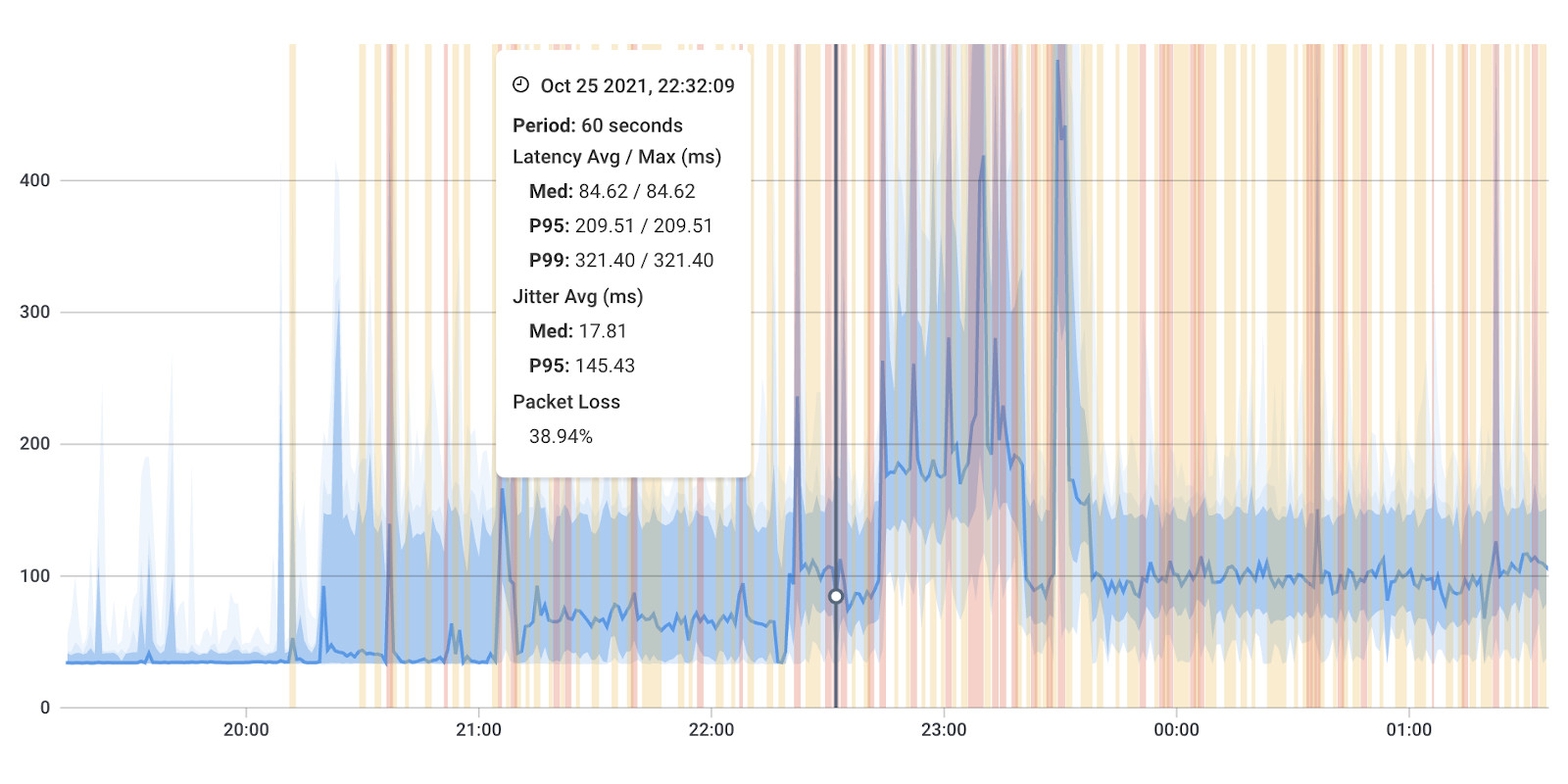
By monitoring these network metrics, you can gain insights into the performance, stability, and reliability of your Google Cloud Interconnect. Continuous monitoring allows you to detect and address any issues promptly, optimize network performance, and ensure a seamless experience for your users.
Monitoring network devices is a critical part of monitoring Google Cloud Interconnect. Network devices like routers, switches, and firewalls play a critical role in network connectivity and can impact Google Cloud Interconnect performance.
Obkio's Network Device Monitoring feature is here to clear the storm! Obkio’s Network Device Monitoring features uses Ultra-Fast Polling (every 30 seconds) to monitor your network devices and provide results that are far more precise than the traditional software polling, which occurs every 5 minutes.

When monitoring Google Cloud Interconnect, it's important to consider monitoring the following network devices:
- Routers: Routers play a critical role in routing traffic between your on-premises network and Google Cloud. Monitoring routers helps you track their performance, utilization, and health. By monitoring router metrics such as CPU usage, memory utilization, interface status, and traffic patterns, you can identify any potential bottlenecks or issues impacting your Google Cloud Interconnect.
- Switches: Network Switches are responsible for connecting devices within your network infrastructure. Monitoring switches allows you to ensure their proper functioning, identify any connectivity issues, and track network traffic patterns. Key switch metrics to monitor include port status, traffic utilization, error rates, and network congestion.
- Firewalls: Firewalls provide security by controlling incoming and outgoing network traffic. Monitoring firewalls is crucial for ensuring the security and performance of your Google Cloud Interconnect. Monitoring firewall metrics, such as packet filtering, connection state, throughput, and security logs, helps you detect any anomalies, potential security breaches, or performance issues.
- Load Balancers: Load balancers distribute incoming network traffic across multiple servers or instances to ensure efficient resource utilization and high availability. Monitoring load balancers helps you track their performance, health, and traffic distribution. Important load balancer metrics to monitor include active connections, response times, server health checks, and traffic distribution across backend servers.
- Network Monitoring Probes/Agents: Deploying network monitoring probes or agents at strategic points within your network infrastructure allows you to collect detailed performance data. These probes or agents can measure key network metrics such as latency, packet loss, bandwidth utilization, and response times. They provide real-time visibility into the performance of your Google Cloud Interconnect from different network segments.
- Network Interfaces: Monitoring the network interfaces on your routers, switches, and other network devices is essential to understand the traffic flow and performance at each connection point. By monitoring interface metrics such as throughput, errors, discards, and utilization, you can identify any performance issues, congestion, or errors affecting your Google Cloud Interconnect.
Monitoring these network devices and their associated metrics gives you a comprehensive view of the health, performance, and security of your Google Cloud Interconnect. It allows you to proactively detect and address any network-related issues, optimize performance, and ensure a smooth and reliable connection between your on-premises network and Google Cloud.


That's it! It's as simple as that.
Obkio’s Monitoring Agents will then send packets to each other every 500ms to measure Google Cloud Interconnect metrics and identify network issues. Continuously monitoring Google Cloud Interconnect allows you to:
- Detect Google and network outages within 5 seconds
- Identify network degradation within a minute
- Go back in time to analyze network performance for every minute of the previous week
Obkio’s Traceroutes are also executed periodically in both directions to identify hop-by-hop issues and keep track of the historial latency between hops.
This monitoring setup also allows you to schedule Speed Tests between Monitoring Agents to monitor network speed and test the available throughput on the connection between the on-premise infrastructure and Google Cloud.
Using all these features combined, you can much more easily and quickly identify and troubleshoot network performance issues.
7 Most Common Google Cloud Interconnect Performance Issues You Can Uncover by Monitoring Google Cloud
Optimizing the performance of your Google Cloud Interconnect is crucial for delivering a seamless and responsive experience to your users. However, various network issues can impact the performance and reliability of your network connection. Understanding these potential challenges and their effects is essential for effectively managing your Google Cloud Interconnect.
In this section, we'll explore common network issues that you can detect and troubleshoot using Obkio to monitor Google Cloud Interconnect!
- Latency: High latency, or delay in the transmission of data packets, can impact the responsiveness of your Google Cloud Interconnect. Latency issues can be caused by factors such as long physical distances between your on-premises network and Google Cloud, suboptimal network configurations, congestion, or inefficient routing. High latency can lead to slow application response times and decreased user experience.
- Packet Loss: Packet loss occurs when data packets fail to reach their destination. It can result from network congestion, faulty network equipment, or unstable connections. Packet loss can negatively impact data integrity, application performance, and user experience. In the context of Google Cloud Interconnect, packet loss can disrupt data transfers and lead to retransmissions, affecting overall performance.
- Bandwidth Limitations: Insufficient bandwidth can lead to performance degradation in your Google Cloud Interconnect. When the available bandwidth is not enough to handle the traffic demands, it can cause congestion, increased latency, and reduced data transfer speeds. Bandwidth limitations can affect applications that require high data throughput or involve large-scale data transfers.
- Network Congestion: Network congestion occurs when there is an excessive amount of data traffic competing for limited network resources. Congestion can result in increased latency, packet loss, and decreased overall network performance. It can be caused by factors such as inadequate network capacity, bursty traffic patterns (packet bursts), or suboptimal network configurations.
- Network Misconfigurations: Incorrect network configurations can significantly impact the performance of Google Cloud Interconnect. Misconfigurations can include incorrect routing settings, improper Quality of Service (QoS) configurations, or suboptimal network architecture. These issues can lead to inefficient traffic routing, performance bottlenecks, or unnecessary network hops, affecting the overall performance of your network connection.
- Network Equipment Failures: Hardware failures or malfunctions in routers, network switches, or other network devices can disrupt your Google Cloud Interconnect. Equipment failures can result in network outages, degraded performance, or intermittent connectivity issues. Monitoring network devices and promptly addressing any hardware failures is essential for maintaining a reliable and high-performing network connection.
- External Factors: External factors such as natural disasters, power outages, or disruptions in internet service provider (ISP) networks can impact the performance of your Google Cloud Interconnect. These factors are beyond your control but can cause significant disruptions to your network connectivity and affect the overall performance of your network connection.
By proactively monitoring and addressing these network issues, you can optimize the performance of your Google Cloud Interconnect, ensure a reliable connection, and provide a seamless user experience for your applications and services hosted in the cloud.

In this blog post, we showed you how to monitor Google Cloud Interconnect using Obkio's Network Monitoring tool - that's because it's the easiest and most complete technique for getting end-to-end visiblity of your network and Google Cloud performance.
But, to give you a complete overview, here are the various techniques and tools to monitor Google Cloud Interconnect:
There are several network monitoring tools available that provide comprehensive monitoring capabilities for Google Cloud Interconnect. These tools allow you to monitor network performance metrics, visualize network traffic, and set up alerts for any anomalies or threshold breaches.
Get ready to soar through the clouds with our curated list of the 40 best cloud network monitoring tools of 2026!
Learn more

Google Cloud provides its own monitoring service called Google Cloud Monitoring. It allows you to monitor the health, performance, and availability of your Google Cloud resources, including Google Cloud Interconnect. With Cloud Monitoring, you can set up custom dashboards, create network monitoring alerts, and analyze performance data. You can also integrate Cloud Monitoring with other Google Cloud services for comprehensive monitoring and analysis.
Deploying network performance monitoring probes or agents at strategic locations within your network infrastructure can provide detailed insights into Google Cloud Interconnect performance. These probes collect network metrics such as latency, packet loss, bandwidth utilization, and jitter.
Tools like Obkio and ThousandEyes offer network monitoring solutions that include probes for monitoring network performance and troubleshooting connectivity issues. The steps we showed you in this article use this Agent-based network monitoring approach!

Performance testing tools, such as Apache JMeter or Gatling, can be utilized to simulate and measure the performance of your applications and network connections. These tools allow you to create test scenarios, generate traffic, and measure response times and throughput. By conducting performance tests, you can identify potential bottlenecks and assess the impact on your Google Cloud Interconnect performance.
Analyzing network logs can provide valuable insights into network performance and potential issues affecting Google Cloud Interconnect. Tools like ELK Stack (Elasticsearch, Logstash, and Kibana) or Splunk enable you to aggregate, analyze, and visualize log data. By monitoring and analyzing network logs, you can identify patterns, detect anomalies, and troubleshoot performance issues.
Synthetic monitoring involves simulating user interactions with your applications or services hosted on Google Cloud Interconnect. It helps identify performance issues, downtime, or connectivity problems that can impact the user experience.
Synthetic monitoring is generally a feature of Network Monitoring tools like Obkio. Obkio is a cloud-based synthetic network monitoring solution that allows IT teams to simulate user interactions with network resources to test network performance and detect issues. Obkio uses synthetic traffic (UDP Packets) to simulate real-user behaviour and monitor every end of your network, from WAN to LAN.

By employing these techniques and utilizing the appropriate monitoring tools, you can gain visibility into the performance and health of your Google Cloud Interconnect. This allows you to proactively monitor, troubleshoot, and optimize your network connection to reduce network disconnection and improve performance, reliability, and user satisfaction.
Congratulations, you've reached the end of our exhilarating journey through the world of monitoring Google Cloud Interconnect and network performance! Armed with knowledge and a dash of tech prowess, you're now equipped to tackle any network challenge that comes your way.
Remember, monitoring Google Cloud Interconnect isn't just about optimizing performance; it's about unleashing the full potential of your cloud endeavors. By keeping a watchful eye on network metrics, swiftly resolving issues, and embracing the power of monitoring tools like Obkio, you can soar to new heights in the cloud.
Put It to the Test: Trying Is the Ultimate Way to Learn!
Let your Google Cloud Interconnect shine brighter than ever before with Obkio!
To ensure lightning-fast speeds, minimal downtime, and a user experience that leaves them breathless.
- 14-day free trial of all premium features
- Deploy in just 10 minutes
- Monitor performance in all key network locations
- Measure real-time network metrics
- Identify and troubleshoot live network problems



























 Obkio Blog
Obkio Blog



